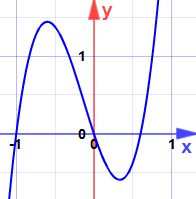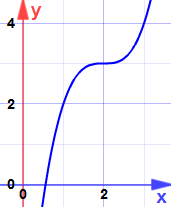how to find local maxima and minima
Finding Maxima and Minima using Derivatives
Where is a function at a high or low betoken? Calculus can aid!
A maximum is a high point and a minimum is a low indicate:

In a smoothly changing function a maximum or minimum is always where the function flattens out (except for a saddle point).
Where does it flatten out? Where the gradient is zero.
Where is the slope zilch? The Derivative tells u.s.a.!
Allow's dive right in with an example:

Example: A ball is thrown in the air. Its summit at any fourth dimension t is given past:
h = iii + 14t − 5tii
What is its maximum height?
Using derivatives we can find the slope of that function:
d dt h = 0 + 14 − 5(2t)
= xiv − 10t
(Meet below this example for how we found that derivative.)

Now find when thegradient is zero:
fourteen − 10t = 0
10t = 14
t = xiv / 10 = 1.4
The slope is zilch at t = one.4 seconds
And the height at that time is:
h = 3 + xiv×one.iv − five×1.42
h = 3 + nineteen.half dozen − 9.eight = 12.eight
And so:
The maximum height is 12.8 m (at t = 1.4 south)
A Quick Refresher on Derivatives
A derivative basically finds the gradient of a part.
In the previous example we took this:
h = three + 14t − 5t2
and came up with this derivative:
d dt h = 0 + xiv − 5(2t)
= fourteen − 10t
Which tells us the slope of the function at any fourth dimension t

We used these Derivative Rules:
- The slope of a constant value (like 3) is 0
- The gradient of a line like 2x is ii, so 14t has a slope of fourteen
- A square function similar tii has a slope of 2t, so 5t2 has a slope of five(2t)
- Then we added them up: 0 + 14 − five(2t)
How Practise We Know it is a Maximum (or Minimum)?
Nosotros saw it on the graph! But otherwise ... derivatives come to the rescue once again.
Have the derivative of the gradient (the 2d derivative of the original function):
The Derivative of 14 − 10t is −ten
This ways the gradient is continually getting smaller (−10): traveling from left to right the gradient starts out positive (the function rises), goes through goose egg (the apartment point), and then the slope becomes negative (the office falls):

A slope that gets smaller (and goes though 0) means a maximum.
This is chosen the Second Derivative Exam
On the graph to a higher place I showed the slope before and after, but in do we practise the test at the signal where the slope is zero:
Second Derivative Exam
When a function's slope is zero at x, and the second derivative at x is:
- less than 0, it is a local maximum
- greater than 0, it is a local minimum
- equal to 0, then the examination fails (there may be other ways of finding out though)
"Second Derivative: less than 0 is a maximum, greater than 0 is a minimum"
Case: Notice the maxima and minima for:
y = 5xiii + 2x2 − 3x
The derivative (slope) is:
d dx y = 15xii + 4x − iii
Which is quadratic with zeros at:
- x = −iii/v
- ten = +1/3
Could they be maxima or minima? (Don't await at the graph notwithstanding!)
The second derivative is y'' = 30x + iv
At ten = −3/5:
y'' = xxx(−iii/5) + 4 = −xiv
it is less than 0, so −3/5 is a local maximum
At x = +1/iii:
y'' = 30(+1/3) + 4 = +xiv
information technology is greater than 0, so +i/three is a local minimum
(Now y'all can look at the graph.)

Words
A high point is chosen a maximum (plural maxima ).
A low betoken is chosen a minimum (plural minima ).
The general word for maximum or minimum is extremum (plural extrema).
Nosotros say local maximum (or minimum) when there may be higher (or lower) points elsewhere but not nearby.
One More than Example
Example: Find the maxima and minima for:
y = x3 − 6xii + 12x − 5
The derivative is:
d dx y = 3xii − 12x + 12
Which is quadratic with only one cipher at x = 2
Is information technology a maximum or minimum?
The 2nd derivative is y'' = 6x − 12
At x = 2:
y'' = half-dozen(ii) − 12 = 0
information technology is 0, so the test fails
And here is why:

Information technology is an Inflection Point ("saddle point") ... the slope does become nada, but it is neither a maximum nor minimum.
Must Be Differentiable
And in that location is an important technical bespeak:
The office must be differentiable (the derivative must exist at each betoken in its domain).
Example: How about the function f(x) = |x| (accented value) ?
| |ten| looks similar this: |  |
At x=0 it has a very pointy change!
In fact it is not differentiable there (as shown on the differentiable page).
Then nosotros tin can't utilize the derivative method for the absolute value part.
The function must also be continuous, but any function that is differentiable is besides continuous, so we are covered.
Source: https://www.mathsisfun.com/calculus/maxima-minima.html
Posted by: rettigthedidismind.blogspot.com

0 Response to "how to find local maxima and minima"
Post a Comment